#Causes of thyroid in female
Explore tagged Tumblr posts
Text
Thyroid plays a vital role in your health. Learn about thyroid function, disorders, and management tips for optimal wellness.
0 notes
Text

Thyroid: Causes, Symptoms, and Treatment
TSH tells the thyroid what needs to be done to get the body back to normal. As long as these hormones are released in the correct quantity, your metabolism will function with no hitch. But if this goes out of whack—as it sometimes does, it leads to hyper- or hypothyroidism.
Read more to know the causes and symptoms of Thyroid: https://www.freedomfromdiabetes.org/blog/post/thyroid-causes-symptoms-and-treatment/2876
#thyroid#thyroid symptoms#thyroid problems#what is thyroid#normal thyroid levels#types of thyroid#thyroid causes#thyroid side effects#symptoms of thyroid#thyroid disease#thyroid symptoms in male#thyroid symptoms and cure#causes of thyroid in female
0 notes
Text
comes out of the "googling things about the disorder you have and then googling a vague medical term and not getting a clear answer and complaining about the vagueness of the term to your friend who probably has more familiarity with the term and it's implications in context" session covered in blood and wailing and writing on the floor
#Anyway I have not gotten more than 2 paragraphs in to a study talking about how thyroid disorders can potentially cause#Permanent Consequences To Brain Development if they aren't treated at important times. And I struggled because they used#The term ''adult onset'' and looking it up was vague and like it SAID ''post puberty'' but the same definition said#''later in life'' and that part was HIGHLIGHTED BY GOOGLE so I missed the puberty part but even beyond that#Hypothyroidism is most commonly diagnosed in ppl who are like 50+ I believe so does ''later in life'' mean ''not a child'' or#''genuinely middle aged'' in this context specifically because stuff talking about hypothyroidism mostly talks about it either#In terms of Congenital Hypothyroidism and Hypothyroidism (which they mention is most common in ppl assigned female at birth and like 60+)#So there's barely anything talking Abt ppl like Me who got diagnosed in their Mid Teens so probably Mid Puberty and AAAAAAAAAAAAAAAAAA#I'm going to drive into a lake. Thank you to my best friend ever for breaking down the term and how it's used in medical contexts for me#I owe you my life#Anyway part of the reason this was so fucking Much: thing I'm reading (like an actual medical study) mentions that the cognitive issues#Associated w ''adult onset hypothyroidism'' are largely reversible but before then untreated hypothyroidism can have significant effects on#Brain development and while I caught mine early and got medicated when I was ~18 I had a gap in treatment#Bc I aged out of my pediatrician and didn't have the motivation to actually Get A New Doctor As An Adult (yay mental illness)#Which like. Lead to a Months Long gap in medication. And like I could've BEEN medicated if I put in the work but I felt fine with skipping#My meds bc from what I knew about hypothyroidism it obviously had Symptoms but not ones that would have Significant Long Term Consequences#Like I thought ''oh I'll have depression and fatigue when I'm unmedicated'' NOT REALIZING THAT BEING UNMEDICATED COULD HAVE A SIGNIFICANT#LONG TERM IMPACT EBCAUSE OF HOW IMPORTANT THE THYROID IS TO FUCKING EVERYTHING IN YHE GOD DAMN BODY#THAT EVEN PROPER FUTURE MEDICATION COULD NOT NECESSARILY TAKE CARE OF#And like hey: maybe that's on me for not connecting the dots or something. Maybe I knew the thyroid controlled a lot of hormones but#I just didn't make the connection that that means it can have Permanent Irreversible effects when left untreated#But also HEY THIS IS THE KIND OF SHIT YOU SHOULD SPELL OUT TO PEOPLE ESPECIALLY PEOPLE WHO MIGHT HAVE COGNITIVE DIFFICULTIES AND THEREFORE#STRUGGLE WITH THINGS THAT SHOULD BE ''OBVIOUS''. Anyway I'm mad
1 note
·
View note
Text
#weight loss in thyroid#hyperthyroidism symptoms#hyperthyroidism treatment#hyperthyroidism symptoms in females#hyperthyroidism doctor in Ahmedabad#hyperthyroidism causes
0 notes
Text
Hyperthyroidism: Its Important Symptoms, Causes, Treatment And Lifestyle
Hyperthyroidism: Symptoms, Causes, Treatment And LifestyleIntroductionFunction Of Thyroid GlandWhat is Hyperthyroidism?Causes of HyperthyroidismSymptoms Of Hyperthyroidism Physical Manifestations Emotional RollercoasterDiagnosis Of HyperthyroidismTreatment Options: Bringing Harmony Back Medications Radioactive Iodine Therapy Surgical InterventionEmbracing a New Rhythm: Living with…
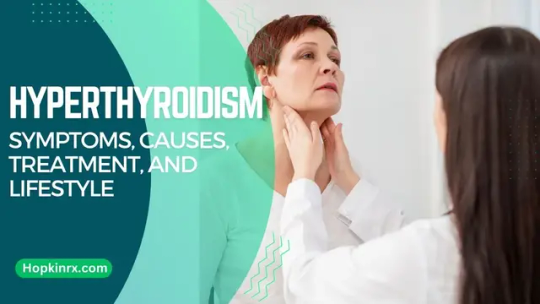
View On WordPress
#amiodarone induced thyrotoxicosis#complications of hyperthyroidism#elevated thyroid levels#factitious hyperthyroidism#goiter hyperthyroidism#graves disease hyperthyroidism#graves disease medication#graves disease tsh levels#high thyroid symptoms#hyper thyroid#hyper thyroid symptoms#hyperthyroidism#hyperthyroidism causes#hyperthyroidism hair loss#hyperthyroidism in men#hyperthyroidism medication#hyperthyroidism signs and symptoms#hyperthyroidism symptoms#hyperthyroidism symptoms in females#hyperthyroidism treatment#hyperthyroidism tsh levels#hyperthyroidism weight loss#hypo and hyperthyroidism#hypothyroidism and hyperthyroidism#i cured my hyperthyroidism#medicine for hyperthyroidism hyperthyroidism symptoms in men#over active thyroid#overactive thyroid gland#overactive thyroid medication#overactive thyroid symptoms
0 notes
Text
Fish of the Day
Today's fish of the day is the guppy, by special request of @guppiesareamazing !
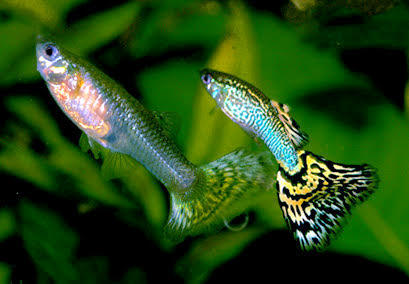
The guppy, also known as millions in some English dialects, and scientific name Poecilia reticulata, is a well known freshwater fish. Common across every continent but Antartica, the natural range of the guppy stretches across the warm and tropical waters of South America and the Caribbean, from as far North as Venezuela, far South as Bolivia, and stretching Pacific to Atlantic oceans. Living in smaller streams or ponds due to poor swimming skills in faster waters, these fish are known for their ability to withstand brackish and slightly salty freshwaters, with an ability to be acclimated to saltwater (similar to their close relatives, mollies). Although, saltwater guppies have far fewer offspring. These fish are benthic, living on the river bed, but require water temperatures around 23-24 °C to survive. They can live in any elevation, with some restriction on increased pressure, and due to their highly adaptable way, are incredibly common in the aquarium trade!

The reason for the widespread populations across the globe is due to their habit of eating mosquito larvae, meaning they were often intentionally imported in an effort to control malaria. Although current studies show this was ineffective at best as a control method. However, these populations have caused issues worldwide. Since they are highly adaptable, guppies tend to kill out local species, bringing both competition for food, and disease. In particular, guppies are known for carrying: a parasitic flatworm species known as Gyrodactylus turnbulli which causes the host to swim erratically before dying, waiting for other fish to feed on the corpse so it can infect another host. Along with fin rot, ich, swim bladder disease, and columnaris bacteria, all of which is infectious to other fishes. In the United States, guppies are known particularly for being a problem along the Southwest, and Southeast, driving out cyprinids and killifishes, and damaging damselfly populations.
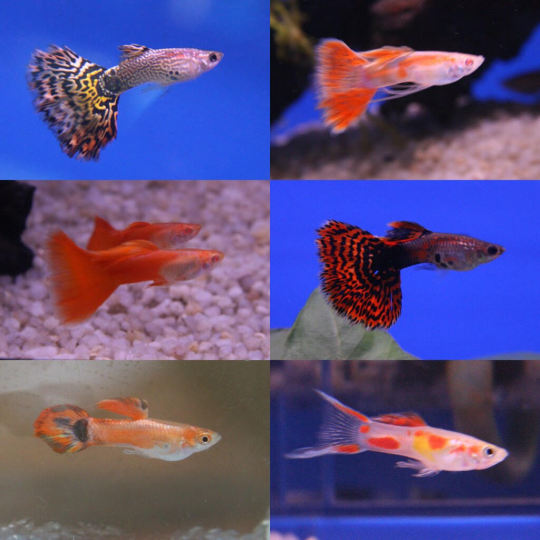
As discussed earlier, the diet of the guppy is made up of algae, zooplankton, insects/larvae, and surrounding detritus. Foraging for sustenance is common, and they travel in shaling groups as large as 30 individuals. These foraging groups help keep the fish calm, and spending less energy on anti predatory behaviours, leading to guppies that are less aggressive and less competitive, the same reason they need to be kept with multiple of their species in hobby tanks and captivity. In both wild and captivity, this fish is often predated on, especially considering they only grow to an adult size of 4-7cm in length.
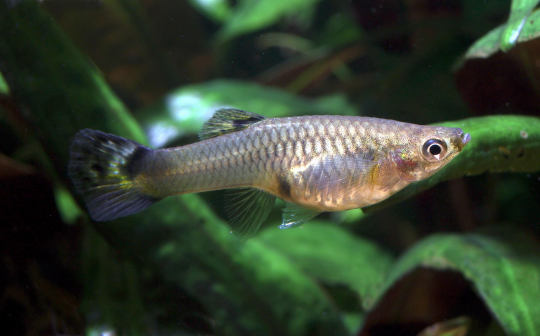
However, guppies have several tactics for avoiding predation. Considering the bright colors of male guppies, the schools help populations of guppies under high predations, as sholes band together to make antipredator decisions. In these groups, some guppies act as inspectors, approaching predators to assess the danger, and are thought to report back to the larger group, although research is still being conducted. Other tactics, such as the ability to darken the iris of the eyes from silver to black, draws predator attention toward the head of the animal, giving the fish an easier time pivoting out of the way of a strike than if the predator aims for the center of mass. All these abilities to avoid predators only aid the guppies ability to adapt to new areas, making them such an issue as an invasive species.
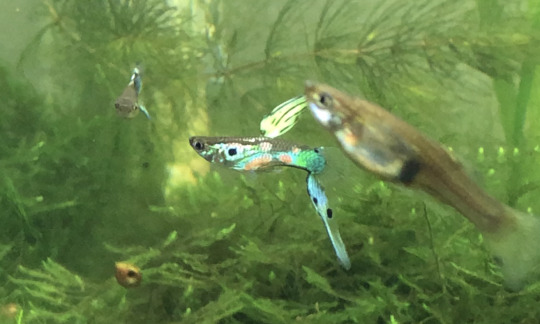
The lifecycle of the guppy is like that of many other small fish. There are two generations per year, as male fish mature at the ripe age of 2 months and females mature at 3 months, with maturity causing males to exhibit sexul dimorphism dependent on the amount of a certain thyroid hormone that influences color patterns, as female guppies are attracted to brighter colors. Many of these bright colored males are bred specifically for different bright and flashy colors in the freshwater trade, leading to the many different variants of them in the hobby aquarium market. Their total lifespan is only around 2 years, and most fish will survive to see 3 breeding seasons total throughout their lifespan.
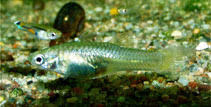
Female guppies give birth to live young, who can swim immediately and are often eaten by the parents soon after birth. In mating itself, females will take on multiple male mates a season, despite being incredibly picky about which they choose. This is thought to be in an effort to avoid inbreeding. Most of the choices that female fish make are based on the number and prevalence of orange spots on the flank and caudal tail of the fish. The orange spots are made up of a pigment that the guppies can not synthesize, and must be obtained in the diet. These spots show how healthy the male is, and is a good show for the presence of parasites. After a show of courtship behaviour and an acceptance, the female fish will gestate for 21-30 days, before giving birth to anywhere from 30-200 fry over the course of several hours. Although common, female guppies do not always eat their fry, and this can be prevented entirely by keeping the adult guppies happy and full of live prey, such as brine shrimp, well raising fry.
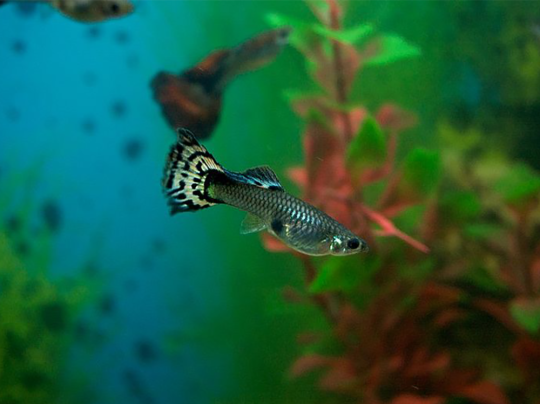
That's the guppy, everybody! Hope everyone has a wonderful day!

#guppy#guppies#Poecilia reticulata#fish#fish of the day#fishblr#fishposting#aquatic biology#marine biology#freshwater#freshwater fish#animal facts#animal#animals#fishes#informative#education#aquatic#aquatic life#nature#river#ocean#hobby tank#freshwater tank
30 notes
·
View notes
Text
The ABCs of Hormones
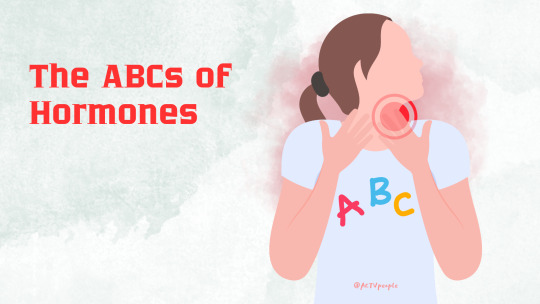
How They Affect Our Mood and Health
Hey friends! Today, let's dive into something that often stays behind the scenes but affects us every single day. Yep, I'm talking about hormones! These tiny chemical substances act as invisible conductors, regulating our mood and emotional state. Let's explore the world of hormones letter by letter, to see which hormones are responsible for our happiness, stress, motivation, and even sluggishness—and most importantly, how to keep them balanced so that life is brighter and more fulfilling.
Hormones That Control Our Mood
A — Adrenaline Adrenaline is the "fight or flight" hormone. It kicks in during stressful situations, giving us the energy to react quickly. This hormone helps us deal with critical moments, improving physical endurance and focus. But be careful—too much adrenaline over time can lead to anxiety.
V — Vasopressin Vasopressin regulates water balance in our body and affects blood pressure. If this hormone drops, we may feel tired and less focused. Maintaining good hydration is important for overall well-being.
G — Ghrelin Ghrelin is known as the "hunger hormone." It signals your brain when it's time to eat. When you're feeling intense hunger, you can thank ghrelin for that. To keep it in check, eat regularly and avoid long gaps between meals.
D — Dopamine Dopamine is the "pleasure hormone." It’s responsible for motivation and rewards. Whenever you feel incredibly inspired or like you can conquer the world, it's probably thanks to dopamine. To keep dopamine levels up, try new hobbies, exercise, and celebrate even the smallest victories. Even watching motivational videos can give your brain a dopamine boost.
E — Estrogen Estrogen is the primary female hormone that regulates the menstrual cycle and affects mood. Fluctuations in estrogen levels can cause mood swings, especially during the premenstrual period. Healthy eating and physical activity help stabilize these fluctuations and maintain balance.
M — Maturity (Testosterone) Testosterone is the "hormone of maturity," especially important for men. It’s responsible for libido, muscle mass, and confidence. Testosterone levels also affect energy and motivation. Exercise and a proper diet help maintain it at a healthy level.
I — Insulin Insulin is the hormone that regulates blood sugar levels. It allows glucose to enter cells and be used for energy. Balancing insulin is key for maintaining stable energy levels and preventing diabetes. Avoiding sugary foods and fast food is a good way to keep insulin levels in check.
C — Cortisol Cortisol is the "stress hormone." It helps the body cope with critical situations, but chronic stress keeps cortisol levels high, leading to fatigue and depression. Meditation, rest, and physical activity are good ways to manage cortisol.
M — Melatonin Melatonin is the sleep hormone, helping us fall asleep and regulating our internal clock. Its level rises in the dark, promoting a restful sleep. To maintain melatonin levels, avoid bright light in the evening and try to go to bed at the same time every night.
O — Oxytocin Oxytocin is the "love and bonding hormone." It’s released when we hug, show affection, or spend time with loved ones. High oxytocin levels help us feel happier and more connected. Hug your loved ones and express affection—it’s a simple and effective way to boost this hormone.
S — Serotonin Serotonin is the "happiness hormone." It regulates mood, sleep, and appetite. Low serotonin levels are often associated with depression and anxiety. To increase serotonin, eat foods rich in tryptophan like bananas, nuts, and dark chocolate, and spend more time in the sunlight.
T — Thyroxine Thyroxine is a thyroid hormone that regulates metabolism. Its imbalance can lead to weight issues and energy problems. Eating enough iodine (like seaweed) and maintaining a healthy lifestyle support normal thyroxine levels.
P — Phenylethylamine Phenylethylamine is often called the "love hormone." It’s released when we feel romantic attraction and helps boost dopamine, adding those wonderful feelings of love and excitement.
Conclusion
That's our ABCs of hormones! It seems like so many little conductors are controlling our mood and health that it can make your head spin. But don't worry! In the next article, we'll talk about what influences hormonal balance and how to keep it in check, so your hormones can be your best friends. Give us a like and stay tuned!
#hormones#hrt estrogen#serotonin#Oxytocin#adrenaline#cortisol#melatonin#insulin#testosterone#dopamine#health and wellness
2 notes
·
View notes
Text
Oedema - pitting vs non-pitting
Oedema is swelling due to excess fluids in tissues.
In pitting oedema, pressing on the affected area leaves an indentation (that persists after removing the pressure). In non-pitting oedema, the area feels firm to touch and does not form indentations.
Pitting oedema:
The excess fluid is mainly composed of water
Commonly caused by heart failure, venous insufficiency, or nephrotic syndrome
Non-pitting oedema:
The excess fluid consists of water WITH protein and salts
Usually indicates a condition of the thyroid / lymphatic system
Different types:
Lymphoedema is due to a build-up of lymphatic fluid (e.g. due to a tumour blocking lymphatic flow / after removal of lymph nodes).
Myxoedema occurs in hypothyroidism and often affected the pretibial or periorbital area.
Angioedema is localised swelling of the skin and is usually due to allergic reactions. It typically affects the face, tongue, larynx, abdomen, arms, and legs. When the larynx is affected, it may affect breathing, which is an emergency!
Lipoedema is when fat accumulates in subcutaneous tissues - it usually affects the legs/buttocks and almost exclusively occurs in postpubertal females (not the same as cellulite!)
If patients present with oedema, it's always important to test if it's pitting or non-pitting as this helps to determine the cause and correct treatment!
#med school#medical student#medicine#revision#medspo#medblr#dermatology#renal#cardiology#oedema#pitting#non-pitting#heart failure
33 notes
·
View notes
Text
Male Gynecomastia Surgery In Delhi
Gynecomastia is enlargement of the glandular tissue of the male breast. It results from an imbalance within the body’s hormonal system, with a relative more estrogen which is a female hormone in comparison to androgen a male hormone. Other factors which might be risk factors for gynecomastia include obesity, use of anabolic steroids to boost athletic performance, consumption of excessive junk food, thyroid disease. The condition may occur during infancy and puberty in normally developing boys.
youtube
Gynecomastia itself has few physical complications, but it can cause psychological and emotional trauma because of its appearance.
Gynecomastia can affect one or both breasts, and may sometimes be uneven. Gynecomastia may settle on its own in some cases but if it persists then surgical correction is the mainstay for its improvement. The procedure includes surgical removal of excess glandular tissue together with liposuction of accumulated fat. It can be done as a day care procedure and performed either under local anesthesia or general anesthesia depending on severity and patient compliance. The surgery helps in regaining the flat appearance of the chest area.
Symptoms of Gynecomastia
Skin excess with hanging appearance of the chest region
Puffiness of Nipple areola complex
Breast tenderness
Swelling of chest area
Candidates for surgical consideration
Must be above 18 years old
Males who feel shy due to the swollen and prominent chest appearance.
Have unsatisfactory results after diet and exercise regime.
Must be in a healthy state.
Self-conscious and disturbed daily routine because of their chest appearance
For better results it is recommended to stop smoking for some weeks before and after the surgery.
Benefits of Gynecomastia Surgery
Improved self-esteem and regaining inner confidence
Help in achieving a more defined physique.
Flatter chest appearance.
Can opt to wear well fitted clothes without feeling self-conscious.
Provides relief from social embarrassment.
Duration
Short duration, usually no admission required.
Post-operative care
After the surgery, the chest area will have little swelling and may be bruised but this is temporary. Immediate wearing of compression garment post-surgery helps to improve swelling and provide support to the treated area. The compression garments must be worn for a minimum of 6 weeks for proper body contouring. Heavy exercises are prohibited for the initial few weeks after the surgery.
youtube
Schedule Your Male Gynecomastia Surgery / Gynecomastia Surgery in Delhi With Dr. Sachin Rajpal
If you are struggling with gynecomastia, contact Dr. Sachin Rajpal, cosmetic and plastic surgeon in Delhi today to schedule a private consultation for your male breast reduction. Dr. Sachin Rajpal is one of the most skilled and experienced cosmetic and plastic surgeon in Delhi who can provide you with outstanding results from your male breast reduction. To arrange a one-on-one consultation or to obtain more information about Male Gynecomastia Surgery In Delhi, contact the practice of Dr. Sachin Rajpal by calling +91-9810302821 today.
Suggested Links:
Liposuction Surgery In Delhi
Abdominoplasty In Delhi
Breast Augmentation In Delhi
Breast Reduction In Delhi
#Gynecomastia Surgery In Delhi#Male Gynecomastia Surgery In Delhi#Plastic Surgeon In Delhi#Cosmetic Surgeon In Delhi#Youtube
3 notes
·
View notes
Text
"Understanding the Hair Growth Cycle and Causes of Hair Loss"
The hair growth cycle involves three distinct phases:
Catagen. The transition (catagen) phase signals the end of active growth. It can last several weeks.
Anagen. The growth (anagen) stage is when new hair fibers actively form within the hair follicles. What you might not know is that this process can last several years. TL;DR: Hair growth definitely doesn’t happen overnight.
Telogen. The resting period (or telogen phase) is when hair follicles become dormant. At any given time, up to 15 percent of the hairs on your body (including facial hair, arm hair and even chest hair) are in the telogen phase. This stage can last up to a year.
Shedding hair every day is normal — up to 200 strands, give or take. Shedding more than this might indicate an underlying hitch in the hair growth cycle.
External and Environmental Causes of Hair Loss
Many factors can disrupt the hair growth cycle and lead to increased shedding such as:
Poor nutrition
Infection
Medication reactions
Stress
Menopause
Constantly wearing hats
Tight hairstyles (ex man bun)
As for the case of male pattern baldness, hormones and genetics are at play.
Let’s start with how hormonal treatments can disrupt your T-levels.
Hormonal Causes of Hair Loss
There is a link between low testosterone levels and issues such as a lower sex drive and poor sexual wellness.
Low-T is a factor and can be caused by conditions like diabetes, autoimmune disease, and thyroid disease.
The following can also cause a temporary dip in testosterone levels:
Over-exercising
Poor nutrition
Certain medications
Testerone Hormone Treatment (often called HRT or TRT) comes with potential side effects, and in some people, it may trigger hair loss.
High testerone causes hair loss, so more T isn't better. Stay with your doctor's instructions. Don't mess around with your dose.
Genetics influence how sensitive your hair follicles are to circulating dihydrotestosterone (DHT). DHT is a byproduct of testosterone and one of the most potent androgens (male sex hormones).
Testosterone and DHT are interlinked, and when T levels rise, DHT levels typically rise as well.
Researchers noted in a 2017 study that was done in Germany, which backs up previous research suggesting that developing bald spots from male pattern baldness might have more to do with sensitivity to testerone than the level itself.
Testerone converts a small amount of what is in your body into DHT by way of the 5-alpha reductase enzyme, which is found in small amounts in the body.
Secondary sex characteristics: any physical characteristic developing at puberty that is not directly involved in reproduction.
Why do we have DHT?
In young males, the body needs DHT to ensure the healthy development of the genitals and prostate. Ftm trans people obviously do not have testicles or a prostate. We focus on secondary sex characteristics like voice, muscle mass, and body hair.
As an adult? DHT doesn’t really have a large job to do anymore. Therefore, it can cause problems, like hair loss. In fact, researchers have found more DHT in balding scalps compared to non-balding ones. But not every guy’s hair follicles are ultra-sensitive to this sex hormone.
The more testosterone, the higher the levels of DHT in your body. That’s not necessarily a death sentence for your hair, but it is a fact.
DHT can attach to receptors in the scalp and gradually shrink hair follicles until they can no longer produce hair — a process known as follicular miniaturization.
If you have a genetic predisposition to DHT sensitivity, too much of it can cause hair loss.
While TRT doesn’t directly cause hair loss, increased Testosterone can lead to androgenic alopecia if the patient has a genetic sensitivity to the hormone DHT (dihydrotestosterone).
Androgenic alopecia is also known as male-pattern baldness and female-pattern baldness. Is the most common cause of hair loss in men and women.
Diagnosing Your Androgenic Alopecia
The first step to avoiding hair loss on HRT is to identify whether you have a genetic sensitivity to DHT. If you don’t, then it’s unlikely that HRT (and a resulting increase in DHT levels) will trigger hair loss.
Male-pattern baldness most often occurs in an M-shaped pattern starting at the forehead. It may also manifest as a slowly growing bald spot on the top/crown of the head. If you notice either of these patterns in your hair, then it’s possible you have male-patterned baldness.
Because androgenic alopecia is a genetic condition, you can also look at your family line for any signs of hair loss, as well. A common myth is that hair loss is inherited from the mother’s side, but in actuality, both parents can pass down the genes that lead to androgenic alopecia. This condition is polygenic, meaning it comes from multiple genes rather than just one.
It’s useful to work with a knowledgeable provider when diagnosing androgenic alopecia. Defy Medical offers consultations to discuss this topic in detail.
DHT Blood Testing
If you’re experiencing hair loss but aren’t sure it’s androgenic alopecia, or if you don’t have any symptoms but still want to check, you can order a DHT blood test. This test measures your DHT levels to determine whether your levels are elevated. Elevated DHT levels along with hair loss often indicate androgenic alopecia.
How to Avoid Hair Loss on (T)HRT
If you do have androgenic alopecia, there are several treatment options to slow and minimize hair loss.
It’s important to catch hair thinning and hair loss as quickly as possible, so you can preserve hair follicles. It’s much more effective to slow hair loss than to grow hair back after it’s gone.
Sources:
https://www.defymedical.com/services/hair-loss/?_gl=1*synut2*_up*MQ..*_ga*MTA5NzY4NDUxNy4xNzEyMTU1NzIx*_ga_XWPYJFFXE5*MTcxMjE1NTcyMC4xLjEuMTcxMjE1NTc0MS4wLjAuMA..
https://www.defymedical.com/blog/how-to-avoid-hair-loss-on-trt/#:~:text=While%20TRT%20doesn't%20directly,baldness%20and%20female%2Dpattern%20baldness.
#transgender#trans ftm#hair loss on t#t and hair loss#ftm transition#ftm educational blog#ftm education blog#trangender#transitioning#hair loss and testosterone#long article#sources listed
5 notes
·
View notes
Text
idk why but i'm feeling really blue today...
among other things, weirdly enough i've been thinking a lot about babies, but before i met my husband i assumed i wouldn't have children. i am not good with other people's children, they make me uncomfortable, but my hubby wants children with me (and realistically it would only be one given today's economy and children are fucking expensive - one of the reasons among many others i'm still grappling with this).
but on top of all of that, my body is going through a lot of changes given my (still suspected) hypothyroidism and autoimmune response to killing said thyroid. i told my hubby a few weeks ago that idk if i would want to carry, because it takes two years for the female body to get back to normal after having a baby, but it's been five months of hormone treatment for my thyroid and i'm scared that i'd get that under control and pregnancy would just wipe me right out again cause 'not normal hormone levels ever again', and while i'm turning 30 this year, he's 35, i feel that pressure, you know? to want to be a mom but that is just another societal norm that i shouldn't feel said pressure to uphold because all of that responsibility, lack of sleep, loss of self, hobby time, job time, isolation from people my age cause caring for a baby, is terrifying for me.
idk, i'm just feeling blue and i know it's my thyroid to blame entirely and maybe that this month is my period month according to my pills, and now i feel like crying i knew i shouldn't have written this all out.
i gotta take the hubby shopping to get new clothes for his promotion at work, then maybe i'll get me something to help me feel better or just come home and...idk really. idk a lot of things anymore of what i want.
#ooc#tbd#literally ignore me ok#this is useless#tw; motherhood (in concept not reality)#tw; societal norms and pressure#tw; depression#tw; chronic illness
4 notes
·
View notes
Text
Iodized Salt: What It Is, Its Benefits and How Much You Should Eat Daily
Keeps weight under control. Your metabolism is directly affected by the healthiness of your thyroid. When you have a super high metabolism, you might not gain a healthy weight. Slower metabolism allows the body to store more fat, thus leading you to gain weight. Since your thyroid depends on a healthy dose of iodine to perform its duty, your metabolism also depends on your iodine levels.
Removes toxins and prevents bacteria. Iodized salt has a counter effect on harmful metals like mercury and lead. It acts to repel these toxins and restore the right pH level in your body. Iodized salt also helps prevent harmful bacteria from multiplying in the intestines. Research shows that harmful bacteria can cause fatigue, constipation, and headaches.
Promotes heart health and keeps you hydrated. Iodized salt helps create the hormones that regulate heart rate and blood pressure. It also helps to burn extra fat deposits that could lead to heart disease. Salt promotes healthy hydration levels and creates a balance of electrolytes. This balance is crucial for the proper functioning of the cells, muscles, tissues, and organs. All the body components require water to function, and salt helps maintain the proper water levels. Dehydration makes you more prone to dizziness, fatigue, and muscle cramps.
Health Risks of Iodized Salt Deficiency
Not having enough iodine amounts can lead to severe health conditions including:
Impaired fetal and infant development
Difficulty in learning during childhood
Fibrocystic breast disease
Radiation-induced throat cancer
Hair loss
Fatigue
Goiter
Weight gain
Increased sensitivity to cold
Dry skin
How Much Iodine Do You Need?
The amount of iodine you should consume in a day depends on your age. If you are female, pregnancy and breastfeeding also play a crucial role. Here are the recommended amounts of iodine one should take in a day:
Birth to six months: 110 micrograms
Infants 7 to 12 months: 130 micrograms
Children 1 to 8 years: 90 micrograms
9 to 13 years: 120 micrograms
Teens 14 to 18 years: 150 micrograms
Adults: 150 micrograms
Pregnant women: 220 micrograms
Breast feeding women: 290 micrograms
Do not consume salt in high amounts as it can pose a danger to your health.
https://newsnetwork.mayoclinic.org/discussion/mayo-clinic-q-and-a-sea-salt-and-sufficient-iodine-intake/#:~:text=The%20recommended%20daily%20intake%20for,of%20iodine%20through%20their%20diets.
The recommended daily intake for adults is 150 micrograms, which can be obtained from about one-half to three-quarters of a teaspoon of table salt. Testing of the general population indicates that most Americans consume sufficient levels of iodine through their diets. Pregnant women and nursing mothers are the only groups in the U.S. that are advised to take a daily iodine supplement, usually as part of a prenatal vitamin.
1 note
·
View note
Text
Audio log #4- Incident #8
Inspired by this video:
youtube
Captain R'Qazz
"Incident report. We had an incident, the first in which 'Specimen 54' was not involved, since his escape with 'Specimen 33' three weeks ago, what is surprising about this incident was the fact that '54' was trying to stop it from getting worse."
"At 2:45 pm, 'Specimens 23', '12' and '7', three of the most aggressive members of the 54 Specimens, began attacking, mauling and mutilating ‘Specimen 40’."
"Through a long period of observation and monitoring, 'Specimen 40' can unfortunately be considered the 'punching bag' of all specimens, We believe that he was the weakest of the 27 males, so much so that many of them kept him away from females, even chasing him away from the Feeding areas. Causing him to isolate himself from others, just like '54' did before forming a bond with '33'."
"And as much as he tried to avoid it, '40' became victim of Bullying from 'Specimen 23' and his two companions, 'Specimen 12' and 'Especimen 7', his 'henchmen' per say, however this was the first time that the three specimens almost put 'Specimen 40' in a state of serious risk or worse..."
"Death."
"According to what one of the guards saw through the monitoring cameras, 'Specimens 23', '12' and '7' began to surround '40', when he was approaching the water hole in the enclosure, and according to what he saw, '23' started roaring, grunting and growling at, '40', from what we believe, he wanted to somehow scare, '40' away."
"But what really surprised the guard was that this time, '40' didn't move away, he wasn’t even scared, on the contrary, he stood his ground, even hissing at, '23' and showing his teeth at him, trying to intimidate him, unfortunately this ended up being his biggest mistake."
"Within seconds, Specimens '23', '12' and '7' began to brutally attack specimen '40', while the rest of the specimens looked on in terror at what they were witnessing at that moment."
"As he continued watching, the guard realized that they were going to kill '40', they quickly raised the alarm and alerted our security team, a team squad entered the enclosure, but as soon as they arrived at the scene, the guards saw something they could not believe."
"According to their witnesses, the guards saw specimens '54' and '33' saving the life of specimen '40'."
"The guards said that they could only watch as, '54' faced '23' while '33' faced specimens '7' and '12' at the same time, quickly the security team acted, neutralizing the fight and taking '40' to somewhere safe."
"According to our doctors' examinations, species '23', '12' and '7' suffered several injuries caused by '54' and '33', with '12' having his nose broken and his jaw dislocated , while '7' received several deep slashes, bite marks and bruises on his body, which was caused by 'Specimen 33'. "
"Meanwhile 'Specimen 23' had a good part of its left wing torn off by 'Specimen 54' along with two huge scars on its face and abdomen, despite that, their injuries would heal."
"Unfortunately... 'Specimen 40' did not have that much luck."
"If the research team had not intervened, 'Specimen 40' could have died that day; even so, there was significant damage to internal structures and part of its anatomy."
"Namely, the larynx and thyroid were completely destroyed by the attack."
"It took twelve hours of surgery to stabilize '40' ."
"Even so, the damage to his guarantee was impossible to repair, as far as we know, 'Specimen 40' is unable to speak from now on."
"At first, we decided that it would be better to isolate him from the other specimens, but one of our men came up with an idea."
"Four weeks after stabilizing, 'Specimen 40' was released into the enclosure, along with specimens '54' and '33', the three were the only specimens there that day, as we observed more, we noticed something interesting."
"As far as we know, 'Specimens 54' and '33' began interacting in a positive way with 'Specimen 40', helping him eat and drink, apparently, the two wanted to help him recover from his traumatic event."
"And it worked."
"Weeks passed and from what we observed, the three specimens formed some kind of bond, with the three walking, eating and talking together."
"When the day came for the others to be released into the enclosure, we realized that the trio had developed a rivalry with '23', '12' and '7', with the two trios dividing the enclosure into two territories, the right side belonging to '54' and the left side belonging to '23'.
However, I cannot say that I am happy with this."
"If this continues to go on, we soon can be seen dealing with more severe and brutal fights like the one that started all this, if we don't find a solution, we could start losing more specimens and we cannot let that happen, cause if it does..."
"Then our deal with the 'Client' is over."
"End of report"
3 notes
·
View notes
Text
Introduction
Um hi, not sure if introductions are done on tumblr! I haven't been on here since I was a teen. I live under a rock and didn't know this was unbanned on iPhone until awhile ago. Anyways, my name is Selena. I am a female. I think this blog will be mostly about my chronic illnesses/chronic pain and probably somewhere to express my mental health issues.
I have multiple autoimmune illnesses. Pretty much dysautonomia. I have POTS, IBS, and hashimoto's.
What are these conditions?
POTS: Postural orthostatic tachycardia syndrome (POTS) is a condition that causes your heart to beat faster than normal when you transition from sitting or lying down to standing up. It’s a type of orthostatic intolerance.
IBS: Irritable bowel syndrome (IBS) is a common disorder that affects the stomach and intestines, also called the gastrointestinal tract.
Hashimoto's: Hashimoto’s disease is an autoimmune disorder that can cause hypothyroidism, or underactive thyroid. Rarely, the disease can cause hyperthyroidism, or overactive thyroid.
Mental health conditions
Depression
Anxiety
6 notes
·
View notes
Text
Trans Women in Sports
I am using this blog post to talk about my opinion on the trans women in sports debate, as well as include information that has been studied to back up my reasons why trans women should be able to be on women’s sport teams. I will say sports is not one of my favorite things but I can still understand that there is inequality in sports.
What started this was chapter 2 of “Gendered Voices, Feminist Visions” (Susan M. Shaw, Janet Lee) the topic of institutions came up. Institutions are “social organizations that involve established patterns of behavior organized around particular purposes, that are based on social norms”. There came the topic of institutions in sports. Many people know that sports are primarily a male dominated industry and women’s sports are grossly underrepresented. Another thing they addressed was transgender women in sports, stating “Trans girls and women are prevented from participating in some sports at some levels and have to demonstrate minimum testosterone levels”. While there have been laws passed to prevent or let trans women play on women’s teams, there is still much discourse on the subject.
While reading “Gendered Voices, Feminist Visions” (Susan M. Shaw, Janet Lee) I questioned a few things, like what about athletes that use steroids? Or what about cisgender (relating to a person whose gender identity corresponds with the sex registered for them at birth)? Women can have high testosterone and a common cause is usually PCOS (polycystic ovary syndrome). They are not expected to have their testosterone levels tested. So I decided to do a bit more research since it is so unfair transgender women would not be able to be on a women’s sports team.
The first thing I decided to research was seeing what testosterone does, in regards to athletic ability. In reading the article “Circulating Testosterone as the Hormonal Basis of Sex Differences in Athletic Performance” by authors; David J Handelsman, Angelica L Hirschberg, and Stephane Bermon. How they explained what testosterone does and how it helps in athletic ability, “The striking male postpubertal increase in circulating testosterone provides a major, ongoing, cumulative, and durable physical advantage in sporting contests by creating larger and stronger bones, greater muscle mass and strength, and higher circulating hemoglobin as well as possible psychological (behavioral) differences”. Overall a man's strength and muscle which does help with their abilities in sports (they produce about 30 times more testosterone than women), which is why sports are split between men and women.
So even though a trans woman could have more testosterone in their bodies than a cisgender woman they should still be able to be on women’s teams. I have two reasons to talk about that I think would help enforce this opinion. Firstly, I would like to talk about how cisgender women can also have high testosterone. The most common reason for this is having PCOS (polycystic ovary syndrome), there are also other conditions that can affect a woman's thyroid. These women are not kicked out of sports because of this and they are not forced to control or minimize their testosterone levels, like how transwomen are expected to. They only test those with XY disorders and chromosomes.Secondly, many transgender people start on hormone replacement therapy, either to enhance the male or female hormones depending on the person. In this case we are talking about feminizing hormone therapy, this adds female hormones to one's body making them present more as a woman. The article “Feminizing hormone therapy” from the mayo clinic website states “Feminizing hormone therapy involves taking medicine to block the action of the hormone testosterone. It also includes taking the hormone estrogen. Estrogen lowers the amount of testosterone the body makes”. Which means that a trans woman's testosterone levels would go down and they would have more estrogen making their hormones fit cisgendered count. There is always a possibility it could still be higher than an average cisgendered woman but as we know even they can have higher levels of testosterone. That doesn't stop them from playing in women’s sports. So if a woman is transgender that should not affect their ability to play on the women's team.
Finally, to answer my first question, what about athletes that use steroids? Well steroids basically just act as testosterone, by building muscle tone and body mass. Steroids do not directly improve an athletes ability, in this article “Anabolic Steroids and Sports: Winning at any Cost” by the New York state department of health they stated how “Many factors determine athletic ability, including genetics, body size, age, sex, diet and how hard the athlete trains”, so really sports is more about what an athlete does to effect their skills and abilities. Sports are for everyone and if someone does not connect to the gender they were assigned at birth, that should not stop them from being on the sports team of the gender they present as.
Sources:
https://www.ncbi.nlm.nih.gov/pmc/articles/PMC6391653/#:~:text=The%20striking%20male%20postpubertal%20increase,well%20as%20possible%20psychological%20(behavioral)
https://www.mayoclinic.org/tests-procedures/feminizing-hormone-therapy/about/pac-20385096#:~:text=It%20blocks%20male%20sex%20hormone,of%20testosterone%20the%20body%20makes
https://www.health.ny.gov/publications/1210/#:~:text=Anabolic%20steroids%20help%20build%20muscle,how%20hard%20the%20athlete%20trains.
"Gendered Voices, Feminist Visions” (Susan M. Shaw, Janet Lee)
2 notes
·
View notes
Text
It’s been awhile...
This will be quite the read, so I’ll keep it all under the cut, with a slight trigger warning. I am talking about my personal life and what I’ve been dealing with. Thank you for being understanding and taking the time to read this post. I love you all. ♡
✧・゚: *✧・゚:* *・゚✧*:・゚✧
I know none of you were probably expecting this. I mean, to be completely honest, I wasn’t expecting this either. However, after still getting many messages in my inbox and love on the content I’ve posted, even though I haven’t been around in... roughly two plus years, I wanted to make a post/announcement for everyone. This is to kind of explain what’s been going on in my life and what my plans are for this blog. Thank you all so much for the continued love and support during my absence.
So, to start off. Why have I been gone so long? Well, that’s a very, very long story that involves a lot of trauma and my personal life, so I’ll keep it as brief as possible. I dealt with a string of abusive relationships, many different jobs, moving several times (and by “several times”, I mean that I moved about 7 or 8 times within a year, including between different states), losing friends, trying to better my health, re-discover who I am, and so much more...
I’m not going to get into the details of my relationships or anything like that, but I would like to briefly talk about my health. I’ve finally gotten the chance to see doctors to get confirmed diagnoses, rather than simply wonder if I have something or not. As of right now, besides the mental illnesses I was already well aware of, I had a diagnosis that confirmed I have rheumatoid arthritis, or RA for short. For those of you that don’t know, it’s an autoimmune disease. I’ll post a link that will give you guys basic info about it so I don’t make this post even longer than it needs to be. To put it into simple terms, however, it’s a chronic autoimmune disease that mostly affects joints. RA occurs when the immune system, which normally helps protect the body from infection and disease, attacks its own tissues. The disease causes pain, swelling, stiffness, and loss of function in joints. Having a diagnosis is relieving but it’s also added a lot of stress to my life. I also have had 2 cancer scares now. The first scare (my lungs), which I got testing for, was clear. But now, on my second one (my thyroid), not so much. I have to wait a year to get retested to make sure nothing has gotten worse. It’s a lot, I know, but something I wanted to open up to you guys about.
Link: https://www.niams.nih.gov/health-topics/rheumatoid-arthritis#:~:text=Rheumatoid%20arthritis%20(RA)%20is%20a,loss%20of%20function%20in%20joints.
I also wanted to take the chance to reintroduce myself. I was still me before, but a lot of things about me were the choices of controlling ex’s, and not my own. So, hey there. My name is Stormi. I’m a 24 year old who is non-binary, born female, with no preference to pronouns. You can refer to me however you’d like, and I’ll be happy regardless. I enjoy listening to music, drawing, reading, writing, making crafts, playing video games, watching videos on YouTube, playing Dungeons & Dragons and so much more. It’s hard to encapsulate the person that I truly am over a post, but I still want to give you guys a little bit of an insight into who I truly am.
As for my plans on this blog... I’m not quite sure. I want to start writing and posting again, I do. But my health complicates that a bit. I think I will, but I won’t take it quite as seriously. What I mean by that is not that I won’t care, but I won’t be stressing myself out with it as much as I used to. I think I’m going to delete every single ask that I have in my inbox, re-work my character masterlist and a few other things and let you guys know when requests are open. When that happens, please feel free to request! Just be patient and give me some time to get to them. Also, in regards to NSFW content, I think the only thing I’m going to be accepting is probably headcanons. Don’t get me wrong, I like my smut just as much as the next person, but it’s really difficult for me to write it at times. I also worry that everything will end up being too similar.
Anyways, if you made it through this entire post, then thank you so much. It really means a lot to me. You all have been wonderful to me over the years, and I hope you all are excited about my gentle return to the world of tumblr. Even if you guys don’t have any requests, feel free to get into my inbox just to talk. As I’ve said before, my blog is a safe space for everyone. Thank you, I love you all :) ♡
8 notes
·
View notes